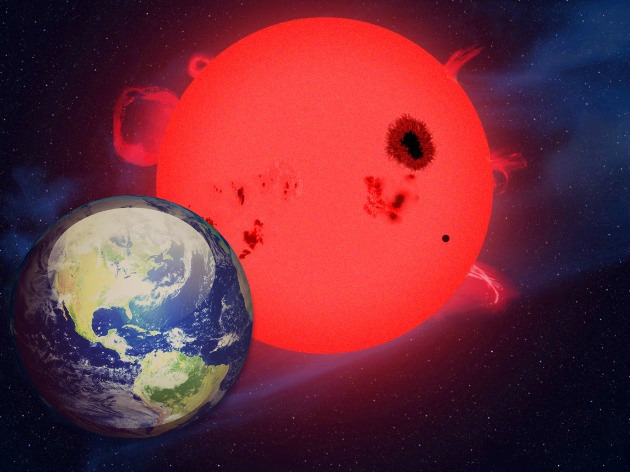

What would happen if our Sun—as it actually exists, in the present—suddenly decreased in mass, plummeting from 1 solar to mass to a mere .5 solar masses? In order to understand what impact this would have on our solar system (and on Earth, especially), you need to have a basic understanding of how mass is related to gravity. Essentially, an increase in mass means an increase in gravity, while a decrease in mass means a decrease in gravity. So if the Sun spontaneously lost half its mass (gasp, shudder, the horror!) then its gravitational pull on Earth would lessen as well, ultimately changing the very nature of our orbit around the Sun. Since the Sun’s pull would be weaker, our orbit would increase (of course, a smaller Sun + larger orbit = not fun times).
With that said, we all (hopefully) know that life on Earth is dependent on the light and heat that it receives from the Sun. If the Sun’s mass abruptly halved, it would certainly have a huge impact on these key points; it would grow cooler and redder and eventually transform into a red dwarf. Because a red dwarf would give off less heat and light (remarkably less), it would have a smaller habitable zone—defined as the region in which liquid water could persist on a planet’s surface. If a planet is located far beyond its star’s habitable zone, odds are, its water will be frozen. Conversely, If a planet is closer inward, it may be too hot for water at all.

In the case of our Sun, the habitable zone begins roughly 67.4 million miles (108 million km) from the solar surface, and stretches some 211.5 million miles (340 million km) outward. Red dwarfs, of the other hand, have habitable zones that start 18.5 million miles (29.7 million km) in, and stretch a mere 9.3 million miles (14.9 million km) beyond. Given Earth’s current distance—93 million miles (150 million km) from the Sun—we wouldn’t stand a chance. If the freezing temperatures don’t off us first, there’s a good chance we may starve, since our plants would no longer be able to photosynthesize.
In essence: The lights would dim, and the Earth would die.
The future would be pretty grim for the outer solar system as well. The gas giants, which are much farther from the Sun, may drift out of the solar system entirely. No more Saturn. No Uranus. No Neptune, and no Jupiter (given the fact that it protects us from stray comets and asteroids, this would be a very bad thing on top of dozens of other really bad things)—traveling at such high velocities, they are simply too massive to be retained by such a paltry Sun.
However, things wouldn’t be so bad for Mercury; It may move into the new habitable zone, which is a bit better than its current mindbogglingly fried position (editor’s note: “mind-bogglingly fried” is not a technical term).
But what if the Sun were always .5 solar masses?
As previously noted, a planet would need to be very close to a red dwarf star in order to be in its habitable zone. Because of the proximity, “any such planet would experience extreme tidal forces, which would affect the ebb and flow of any existing oceans of liquid water. Eventually, it would cause the planet to become tidally locked to the star with one side in infinite daytime, the other side basked in darkness forever. Therefore, the prospect of life arising and evolving on a planet that’s equal parts scorching hot and frozen over seems really slim.”

Of course, this is not one of those hypothetical questions that are pointless to address because it’ll never happen. Here in a few billion years, the Sun will transition from a main-sequence star to a red giant. For a period of time, it will increase in size hundreds of times over, and shed significant quantities of its mass. Eventually, what remains will shrink back down to size, but the damage will be done by then (in 2014, astronomers estimated that the Sun will lose 46 percent of its mass before then).
The Sun—now a shell of its former self—will shrivel up and die, taking Earth, and most of the solar system, with it..